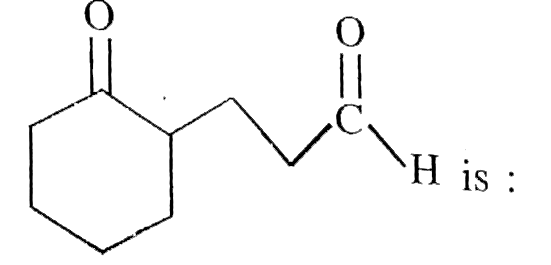An alkene ‘A’ contains three C – C, eight C – H (σ) bonds and one C – C (π) bond. ‘A’ on ozonolysis gives two moles of an aldehyde of molar mass 44 u. Write IUPAC name of ‘A’.
The correct Answer is:But-2-ene
To solve the problem, we need to determine the structure and IUPAC name of the alkene ‘A’ based on the provided information about its bonds and the products formed during ozonolysis.
1. Identify the Number of Carbon Atoms:
- The alkene ‘A’ has 3 C-C bonds and 1 C-C π bond.
- Each C-C bond contributes to the total number of carbon atoms. Since there are 3 C-C bonds, we can deduce that there are 4 carbon atoms in total (because the first bond connects two carbons, and each additional bond connects another carbon).
2. Determine the Number of Hydrogen Atoms:
- The alkene has 8 C-H σ bonds. Each C-H bond corresponds to a hydrogen atom.
- Therefore, the alkene has 8 hydrogen atoms.
3. Construct the Alkene Structure:
- Given that it is an alkene with 4 carbon atoms and 1 double bond (C-C π bond), we can start constructing the structure.
- The general formula for alkenes is CnH2n, which for n=4 gives C4H8. However, we have 8 hydrogen atoms, which fits the formula for an alkene with a double bond.
- A possible structure that fits this description is but-2-ene (CH3-CH=CH-CH3).
4. Ozonolysis Reaction:
- The problem states that ozonolysis of ‘A’ gives two moles of an aldehyde with a molar mass of 44 u.
- The aldehyde formed from but-2-ene upon ozonolysis is acetaldehyde (CH3CHO), which has a molar mass of 44 u (C=12, H=1, O=16).
5. Final Structure Verification:
- The structure of but-2-ene is CH3-CH=CH-CH3.
- Upon ozonolysis, it breaks down to two moles of acetaldehyde (CH3CHO).
6. IUPAC Name:
- The IUPAC name of the alkene ‘A’ is but-2-ene.
Conclusion:
The IUPAC name of the alkene ‘A’ is but-2-ene.
---
- The alkene ‘A’ has 3 C-C bonds and 1 C-C π bond.
- Each C-C bond contributes to the total number of carbon atoms. Since there are 3 C-C bonds, we can deduce that there are 4 carbon atoms in total (because the first bond connects two carbons, and each additional bond connects another carbon).
- The alkene has 8 C-H σ bonds. Each C-H bond corresponds to a hydrogen atom.
- Therefore, the alkene has 8 hydrogen atoms.
- Given that it is an alkene with 4 carbon atoms and 1 double bond (C-C π bond), we can start constructing the structure.
- The general formula for alkenes is CnH2n, which for n=4 gives C4H8. However, we have 8 hydrogen atoms, which fits the formula for an alkene with a double bond.
- A possible structure that fits this description is but-2-ene (CH3-CH=CH-CH3).
- The problem states that ozonolysis of ‘A’ gives two moles of an aldehyde with a molar mass of 44 u.
- The aldehyde formed from but-2-ene upon ozonolysis is acetaldehyde (CH3CHO), which has a molar mass of 44 u (C=12, H=1, O=16).
- The structure of but-2-ene is CH3-CH=CH-CH3.
- Upon ozonolysis, it breaks down to two moles of acetaldehyde (CH3CHO).
- The IUPAC name of the alkene ‘A’ is but-2-ene.
The IUPAC name of the alkene ‘A’ is but-2-ene.
Topper's Solved these Questions
Similar Questions
An alkene ‘A’ contains three C – C, eight C – H (σ) bonds and one C – C (π) bond. ‘A’ on ozonolysis gives two moles of an aldehyde of molar mass 44 u. Write IUPAC name of ‘A’.
View SolutionOne mole of symmetrical alkene upon ozonolysis gives two moles of an aldehyde having the molecular mass 44u. Predict the alkene.
View Solution
Knowledge Check
The IUPAC name of
 isACyclohexanone-2-propanalB2-Formyl ethylcyclohexanoneC3-(-2-oxocyclohexyl) propanalDFormyl cyclohexanone
isACyclohexanone-2-propanalB2-Formyl ethylcyclohexanoneC3-(-2-oxocyclohexyl) propanalDFormyl cyclohexanoneOne mole of a symmetrical alkene on ozonolysis gives two moles of an aldehyde having a molecular mass of 44u. The alkene is:
A2-buteneBetheneCpropeneD1-buteneOne mole of a symmetrical alkene on ozonolysis gives two moles of an aldehyde having a molecular mass of 44u. The alkene is:
AetheneBpropeneC1-buteneD2-butene
One mole of a symmetrical alkene on ozonolysis gives two moles of an aldehyde having a molecular mass of 44 u. The alkene is
View SolutionOne mole of symmetrical alkene on ozonolysis gives two moles of an aldehyde having a molecular mass 58. The alkene
View SolutionOne mole of a symmetrical alkene on ozonolysis gives two moles of an aldehyde having a molecular mass of 44u. The alkene is:
View SolutionOne mole of a symmetrical alkene on ozonolysis gives two moles of an aldehyde having a molecular mass of 44u. The alkene is:
View SolutionOne mole of a symmetrical alkene on ozonolysis gives two of an aldehyde having a molecular mass of 44u. The alkene is :
View Solution
